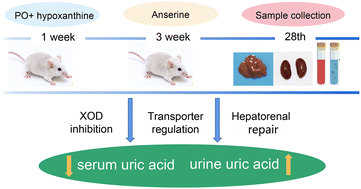Anserine beneficial effects in hyperuricemic rats by inhibiting XOD, regulating uric acid transporter and repairing hepatorenal injury
Abstract
This study aims to investigate the anti-hyperuricemia effect and mechanism of anserine in hyperuricemic rats. Hyperuricemic rats were induced with a combination of 750 mg per kg bw d potassium oxazinate (PO) and 200 mg per kg bw d hypoxanthine for a week, and the rats were separately orally administered anserine (20, 40, 80 mg kg−1) and allopurinol (10 mg kg−1) for three weeks. The results show that the content of serum uric acid (SUA) decreased by approximately 40% and 60% after the intervention of anserine and allopurinol, respectively. The activity of superoxide dismutase (SOD) was increased and the levels of malondialdehyde (MDA), alkaline phosphatase (ALP) and alanine aminotransferase (ALT) were significantly decreased in the anserine groups. After the administration of anserine, the contents of blood urea nitrogen (BUN) and creatinine (Cr) were reduced in the kidney, and the levels of the proinflammatory cytokines IL-1β, IL-6β, TNF-α and TGF-β and inflammatory cell infiltration were reduced in both the liver and kidney. Moreover, the gene expressions of xanthine oxidase (XOD), renal urate transporter 1 (URAT1) and glucose transporter type 9 (GLUT9) were downregulated by anserine administration, and the gene expressions of ATP-binding cassette transporter G2 (ABCG2), organic anion transporter 1 (OAT1) and organic anion transporter 3 (OAT3) were upregulated at the same time. These findings suggest that hepatorenal injury was repaired by anserine, which further regulated the expression of hepatic XOD and renal URAT1, GLUT9, ABCG2, OAT1 and OAT3 to relieve hyperuricemia in rats.



 Please wait while we load your content...
Please wait while we load your content...